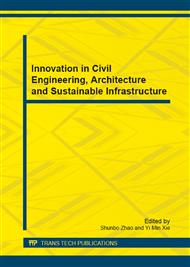p.631
p.635
p.640
p.643
p.648
p.652
p.659
p.663
p.666
Free Vibration Analysis of Frame-Core Tube Structures Attached with Damped Outriggers
Abstract:
The classical outrigger in frame-core tube structure cantilevering from the core tube or shear wall connected to the perimeter columns directly, which can effectively improve the lateral stiffness of the structure. A new energy-dissipation system for such structural system is studied, where the outrigger and perimeter columns are separate and vertical viscous dampers are equipped between the outrigger and perimeter columns to make full use of the relative big displacement of two components. The effectiveness of proposed system is evaluated by means of the modal damping ratio based on the proposed simplified model. The mathematic models of the structural system are obtained with both the assumed mode shape method and finite element method according to the simplified calculation diagram. Based on the modal damping ratio, the optimal damping coefficients of linear viscous dampers are determined, and effectiveness of proposed system is confirmed.
Info:
Periodical:
Pages:
648-651
Citation:
Online since:
November 2012
Authors:
Price:
Сopyright:
© 2012 Trans Tech Publications Ltd. All Rights Reserved
Share:
Citation:


